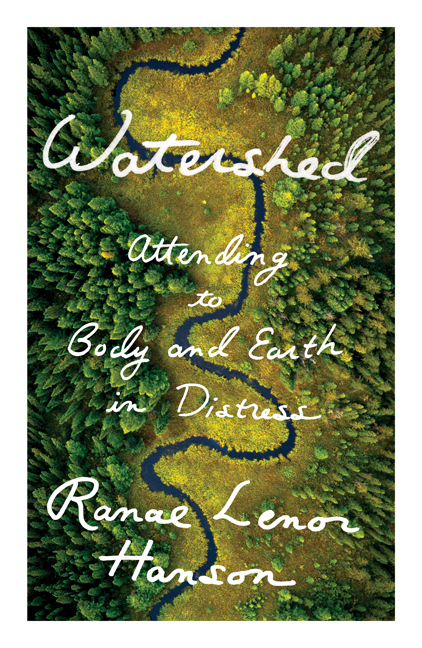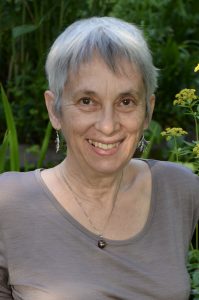
WATERSHED
Attending to Body and Earth in Distress
A personal health crisis, stories from environmental refugees, and our climate in danger prompt a meditation on intimate connections between the health of the body and the health of the ecosystem.
The body of the earth, beset by a climate in crisis, experiences drought much like the human body experiences thirst, as Ranae Lenor Hanson’s body did as a warning sign of the disease that would change her life: Type 1 diabetes. What if we tended to an ailing ecosystem just as Hanson learned to care for herself in the throes of a chronic medical condition.
A personal health crisis, stories from environmental refugees, and our climate in danger prompt a meditation on intimate connections between the health of the body and the health of the ecosystem.
The body of the earth, beset by a climate in crisis, experiences drought much like the human body experiences thirst, as Ranae Lenor Hanson’s body did as a warning sign of the disease that would change her life: Type 1 diabetes. What if we tended to an ailing ecosystem just as Hanson learned to care for herself in the throes of a chronic medical condition. This is the possibility explored in a work that is at once a memoir of illness and health, a contemplation of the surrounding natural world in distress, and a reflection on the ways these come together in personal, local, and global opportunities for healing.
Beginning with memories from a childhood nurtured among the waters of Minnesota, Watershed follows the streams and tributaries that connect us to our world and to each other, as revealed in the life stories of Hanson’s students, Minnesotans driven from their faraway homelands by climate disruption. The book’s currents carry us to threatened mangrove swamps in Saudi Arabia, to drought-stricken Ethiopia, to rocks bearing ancient messages above crooked rivers in northern Minnesota, to a diabetic crisis in an ICU bed at a St. Paul hospital. With the benefit of gentle insight and a broad worldview, Hanson encourages us at every turn to find our own way, to discover how the health of our bodies and the health of the world they inhabit are inextricably linked and how attending, and tending, to their shared distress can lead to a genuine, grounded wellbeing.
When, in the grip of a global pandemic, humans drastically change their behavior to preserve human life, we also see how the earth breathes more freely as a result. In light of that lesson, Watershed helps us to consider our place and our part in the health and healing of the world around us.
- University of Minnesota Press
- Paperback
- May 2021
- 200 Pages
- 9781517910976
About Ranae Lenor Hanson
 An educator and committed climate activist, Ranae Lenor Hanson taught writing and global studies at Minneapolis College for thirty-one years.
An educator and committed climate activist, Ranae Lenor Hanson taught writing and global studies at Minneapolis College for thirty-one years.
Praise
“The credo ‘water is life’ has become a key environmental rallying cry in the years since Standing Rock, and this book helps us remember why. It recalls an American past, inhabits a global present, and imagines a working future—it will be an aid to many as they grapple with our difficult moment.” —Bill McKibben, founder of 350.org and author of The End of Nature
“In a direct and often wise voice, through a series of moving, revealing, and entertaining stories, Watershed makes clear the connection between climate change and our own bodies. A difficult task in a culture that ignores the urgency of climate change while denying that human beings are part of nature. Difficult, but needed now while the earth that sustains our bodies is under assault. This book presents us with a paradoxical gift, the idea that we can make use of the aches and pains and illnesses plaguing so many of us to wake up and act in common cause with the earth.” —Susan Griffin, author of Woman and Nature
“Ranae Hanson’s elegy for the Earth and our bodies speaks of the holy, the sacred. The fates of water, our bodies, our communities are intertwined. She gives voice to the voiceless. She reports on the sacred and challenges us to live our lives knowing that the connection to each other and the Earth is the basis for health, the holy, the sacred.” —Carolyn Raffensperger, executive director, Science and Environmental Health Network
“We need Watershed now. There’s no book like it. It’s as clear-eyed and immersive as the northern Minnesota waters that birthed it. It’s the story for our time, and just in the nick of time. With courage and tenderness, Ranae Hanson pulls back the curtain to show us that the harm we have wrought on the world is no longer a future problem to be solved. It is here now in our bodies as much as in our watersheds and forests—and in the beloved homelands of her immigrant-refuge students whose voices and stories pierce any doubt, any ill-founded hope that all will be well.” —Eric Utne, founder, Utne Reader
“Ranae Hanson’s remarkable book is a deep, rich, profoundly personal, and powerful exploration of how we are inseparable from the water that surrounds us, that flows through, around, and beneath our lives. It’s a book that connects us to where we stand, to the place, the watershed, the webs of love, water, family, and nature that hold us throughout our lives. Its roots run deep, its implications even deeper, and it brings many rich gifts for these extraordinary times.” —Rob Hopkins, founder, Transition Movement
“Such a beautiful blend of Ranae Hanson’s own story and how it connects to the deeper story of environmental damage and climate change. The book gains gravitas and urgency by weaving the impact of environmental crisis on our own human bodies with stories from all over the globe. It shows that we must face this worldwide, systemic issue together now.” —Ann Manning, director, Future First Initiatives
“Born in northern Minnesota where waters divide, Ranae Hanson has been communicating with the earth with reverence and empathy since early childhood. Decades of conversations are gathered in Watershed, a beautifully written memoir that weaves together explorations of keenly observed impacts of ecologic damage, climate change, and personal illness. Wisdom that Ranae Hanson has gleaned from many years of service to the earth and her students is now available to us all. It is a captivating, cautionary tale urging humility, respect, and action.” —Ted Schettler, science director, Science and Environmental Health Network
“Watershed is grounded and calming. It brings the full story of ecological disruption into view. Ranae Hanson’s life story combined with an exploration of the real threat and the embodied response that is necessary is a new and important angle to address climate change.” —Julia Nerbonne, executive director, Minnesota Interfaith Power and Light
“This book took me away from this daily dose of gloom and filled me with a sense of preciousness enabling action that isn’t just reaction. Ranae Hanson’s personal and intimate stories are full of unsentimental love for people, trees, plants, and animals displaced by our political and climate brutality. In the stories told here, those of us who are in true community with the world around, close by and far away, find moments of joy and solace by standing side-by-side near the trauma without averting our eyes. The stories point toward possible sustaining acceptance even in the midst of nightmare realities.” —Robert Bosnak, author A Little Course in Dreams
Discussion Questions
1. Chapter 1, “Where Waters Divide,” could be seen as a love song to the land that nurtured the author’s youth. What is the love song you might write yourself to the waters that have nurtured your life thus far?
2. Similarities between diabetes and climate disruption form central images in the book. Which of the comparisons raised resonated for you? Do you have other health conditions that you find mirrored in ecological stress and well-being?
3. At the beginning of the book, the author acknowledges the Indigenous Peoples of the lands she has lived on. At the end, she offers ethical principles as Winona LaDuke spoke them. How does the relationship between the author and Ojibwe people develop? Is that presentation respectful? What attitude does the author suggest readers should take toward the Original Peoples of their own lands? What connection do you have to the people who are indigenous to your home?
4. The sections between chapters offer suggestions for contemplation and action. Which of those meditations or actions did you follow? What did you experience as you did that? Which of those might you suggest to others? What suggestions would you develop yourself?
5. The book relies on personal stories from varied people to give evidence of both harm to and the resilience of ecological communities and the individual bodies that make up those communities. Which stories reached you? Eyewitness reports are not conclusive evidence, so the book also includes statistics. How well did you feel the stories and the statistics supported each other? What further evidence might you seek out to support or refute the claims made in the book?
6. The author records her questioning of the practices, beliefs, and attitudes that her family and original home culture offered her. How does she navigate the conflicts that arise? Might these dilemmas mirror any you have encountered?
7. How does the book reveal racial and economic injustice, especially related to diabetes and climate trauma? How did you respond to the stories and the troubles presented? What have you experienced of this yourself? What actions might you be called to that could further justice, health, and all-life connection?
8. The book gives suggestions about how to live when under extreme stress, even when facing death. Which of those suggestions were helpful to you? Which attitudes will you develop further for meeting times of great strain and imminent death?
9. The central argument of the book might be: “All life on earth is part of a great whole, which is itself living; all parts are in community and communion with all other parts.” Which aspects of that feel truthful to you? How would the difficulties presented in the book be different if most humans lived with that recognition?
10. Watershed focuses on Minnesota communities and waters. To what extent do you find it to speak for waters and their interdependent beings in other areas of earth? What messages could you carry to your home?
11. What conversation grew up between you and the book as you read? Which of the strands given by the book will you carry with you and continue to develop?
